Tire pressure
Tire pressure specifications
 WARNING
WARNING
Follow recommended tire inflation pressures.
Do not underinflate tires. Underinflated tires wear excessively and/or unevenly, adversely affect handling and fuel economy, and are more likely to fail from being overheated.
Do not overinflate tires. Overinflated tires can adversely affect handling and ride comfort, wear unevenly, increase stopping distance, and result in sudden deflation (blowout) because they are more likely to become punctured or damaged by road debris, potholes etc.
Do not overload the tires by exceeding the specified load limit as indicated on the Tire and Loading Information placard on the driver's door B-pillar. Overloading the tires can overheat them, possibly causing a blowout. Overloading the tires can also result in handling or steering problems, or brake failure.
The recommended tire pressures for the tires mounted at the factory can be found on the labels described here.
Option 1) Tire and Loading Information placard on the B-pillar on the driver's side of the vehicle (Y page 362).
The Tire and Loading Information placard contains the recommended tire pressures for cold tires on a fully loaded vehicle and for the maximum permissible vehicle speed.

The specifications given on the following
Tire and Loading Information placard are
examples. Tire pressure specifications are
vehicle-specific and may deviate from the
data shown here. The tire pressures
applicable to your vehicle can be found on
the Tire and Loading Information placard on
your vehicle.
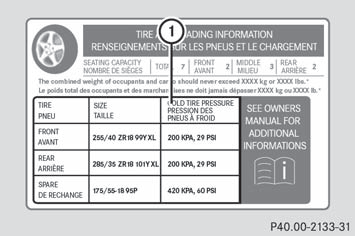
1 Recommended tire pressures
Option 2) Tire pressure table on the inside of the fuel filler flap.
The tire pressure table contains the recommended pressures for cold tires for various operating conditions, i.e. differing load and speed conditions.

Specifications shown in the examples of
tire pressure tables are for illustration
purposes only. Tire pressure specifications
are vehicle-specific and may deviate from
the data shown here. Tire pressure
specifications applicable to your vehicle are located in your vehicle's tire
pressure
table.
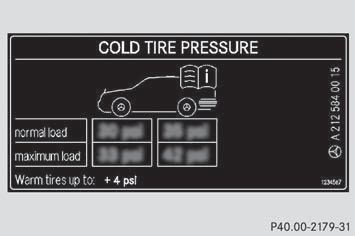
Example: tire pressure table for all tires approved
ex-works for this vehicle
If a tire size precedes a tire pressure, the tire pressure information following is only valid for that tire size. The load conditions "partially laden" and "fully laden" are defined in the table for different numbers of passengers and amounts of luggage. The actual number of seats may differ.
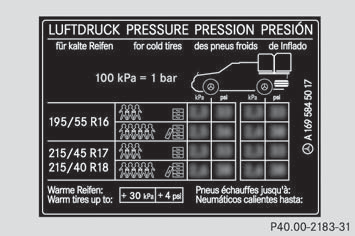
Example: tire pressure table with tire dimensions
Some tire pressure tables show only the rim diameters instead of the full tire size, e.g. R18. The rim diameter is part of the tire size and can be found on the tire sidewall.
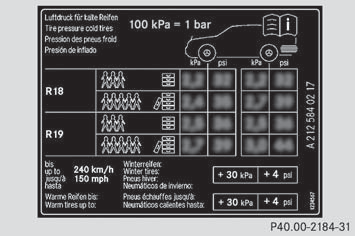
If the tire pressures have been set to the
lower values for lighter loads and/or lower
road speeds, the pressures should be reset
to the higher values:
- if you want to drive with an increased load
and/or
- if you want to drive at higher road speeds.

The tire pressures for increased loads
and/or higher road speeds, shown in the
tire pressure table, may have a negative
effect on driving comfort.

For trailer towing, adjust the tire pressure
of the rear tires to the maximum tire
pressure value stated on the table inside
the fuel filler flap.
Option 3) The tire pressure for the
emergency/collapsible spare wheel
(depending on vehicle equipment) can be
found:
- printed in yellow on the rim of the
emergency/collapsible spare wheel
- in the "Wheel and tire combinations"
section in this manual
- on the Tire and Loading Information placard
on the B-pillar on the driver's side.
If the tire pressure is not set correctly, this can lead to an excessive build up of heat and a sudden loss of pressure.
For further information, consult a qualified specialist workshop, e.g. an authorized Mercedes-Benz Center.
Important notes on tire pressure
 WARNING
WARNING
Should the tire pressure drop repeatedly:
- check the tire for foreign bodies.
- check whether the wheel is losing air or the valve is leaking.
- make sure that only a valve cap approved by Mercedes-Benz is used on the tire valve.
Tire pressures that are too low have a negative effect on vehicle safety, which could lead you to cause an accident.
To test tire pressure, use a suitable tire pressure gauge. The outer appearance of a tire does not permit any reliable conclusion about the tire pressure. On vehicles equipped with the electronic tire pressure monitoring system, the tire pressure can be checked using the on-board computer.
The tire temperature and pressure increase when the vehicle is in motion. This is dependent on the driving speed and the load.
Therefore, you should only correct tire pressures when the tires are cold.
The tires are cold:
- if the vehicle has been parked without
direct sunlight on the tires for at least three
hours and
- if the vehicle has not been driven more than
1 mile (1.6 km).
The tire temperature changes depending on the outside temperature, the vehicle speed and the tire load. If the tire temperature changes by 18 °F (10 °C ), the tire pressure changes by approximately 10 kPa (0.1 bar/ 1.5 psi). Take this into account when checking the pressure of warm tires and only correct the tire pressure if it is too low for the current operating conditions. If you check the tire pressure when the tires are warm, the resulting value will be higher than if the tires were cold. This is normal. Do not reduce the tire pressure to the value specified for cold tires. The tire pressure would otherwise be too low.
Observe the recommended tire pressures for cold tires
- on the Tire and Loading Information placard
on the B-pillar on the driver's side,
- in the tire pressure table on the inside of
the fuel filler flap,
- printed in yellow on the rim of the
emergency/collapsible spare wheel
(depending on vehicle equipment).
Underinflated or overinflated tires
Underinflated tires
 WARNING
WARNING
Follow recommended tire inflation pressures.
Do not underinflate tires. Underinflated tires wear excessively and/or unevenly, adversely affect handling and fuel economy, and are more likely to fail from being overheated.
Underinflated tires can: - wear excessively and/or unevenly - adversely affect fuel economy - fail from being overheated - adversely affect handling
Overinflated tires
 WARNING
WARNING
Follow recommended tire inflation pressures.
Do not overinflate tires. Overinflated tires can adversely affect handling and ride comfort, wear unevenly, increase stopping distance, and result in sudden deflation (blowout) because they are more likely to become punctured or damaged by road debris, potholes etc.
Overinflated tires can: - adversely affect handling - wear excessively and/or unevenly - be more likely to become damaged - adversely affect ride comfort - increase stopping distance
Maximum tire pressure
 WARNING
WARNING
Never exceed the maximum tire inflation
pressure. Follow recommended tire inflation
pressures.
Do not underinflate tires. Underinflated tires wear excessively and/or unevenly, adversely affect handling and fuel economy, and are more likely to fail from being overheated.
Do not overinflate tires. Overinflated tires can adversely affect handling and ride comfort, wear unevenly, increase stopping distance, and result in sudden deflation (blowout) because they are more likely to become punctured or damaged by road debris, potholes etc.
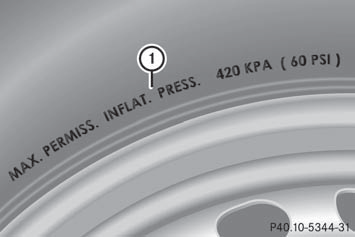
1 Maximum permitted tire pressure (example)

The actual values for tires are specific to
each vehicle and may deviate from the
values in the illustration.
When adjusting the tire pressures always observe the recommended tire pressure for your vehicle.
Checking the tire pressures
Important safety notes
 WARNING
WARNING
Follow recommended tire inflation pressures.
Do not underinflate tires. Underinflated tires wear excessively and/or unevenly, adversely affect handling and fuel economy, and are more likely to fail from being overheated.
Do not overinflate tires. Overinflated tires can adversely affect handling and ride comfort, wear unevenly, increase stopping distance, and result in sudden deflation (blowout) because they are more likely to become punctured or damaged by road debris, potholes etc.
Do not overload the tires by exceeding the specified load limit as indicated on the Tire and Loading Information placard on the driver's door B-pillar. Overloading the tires can overheat them, possibly causing a blowout. Overloading the tires can also result in handling or steering problems, or brake failure.
Check the tire pressure at least once a month.
Only check and correct tire pressures when the tires are cold.
Checking tire pressures manually
To determine and set the correct tire pressure, proceed as follows: – Remove the valve cap of the tire that is to be checked.
– Press the tire pressure gauge securely onto the valve.
– Read the tire pressure and compare it with the recommended value on the Tire and Loading Information placard on the B-pillar on the driver's side of your vehicle.
– If necessary, increase the tire pressure to the recommended value.
– If the tire pressure is too high, release air by pressing down the metal pin in the valve using the tip of a pen, for example. Then check the tire pressure again using the tire pressure gauge.
– Screw the valve cap onto the valve.
– Repeat these steps for the other tires.
Tire pressure loss warning system (Canada only)
Important safety notes
While the vehicle is in motion, the tire pressure loss warning system monitors the set tire pressure using the rotational speed of the wheels. This enables the system to detect significant pressure loss in a tire. If the speed of rotation of a wheel changes as a result of a loss of pressure, a corresponding warning message will appear in the multifunction display.
 WARNING
WARNING
If the Check Tire Pressure Soon message
appears in the multifunction display, one or
more tires are significantly underinflated.
Stop the vehicle as soon as possible and inflate the tires to the pressure specified on the vehicle's Tire and Loading Information placard or (where available) in the tire pressure table.
Driving on a significantly underinflated tire causes the tire to overheat and can lead to tire failure. Underinflation also reduces fuel efficiency and tire tread life, and may affect the vehicle's handling and stopping ability.
Check all tires when cold, including the spare tire, at least once a month. The tires should be inflated to the recommended pressure.
This information can be found:
- on the Tire and Loading Information placard
on the B-pillar on the driver's side
or
- in the table for the tire pressure on the
inside of the fuel filler flap
 WARNING
WARNING
The tire pressure loss warning system does
not provide a warning for wrongly selected tire
inflation pressures. Always adjust tire
inflation pressure according to the Tire and
Loading Information placard on the driver's
door B-pillar or on the tire inflation pressure
label located on the inside of the fuel filler flap.
The tire pressure loss warning system does not replace regular checks of the tire inflation pressures since a gradual pressure loss in more than one tire cannot be detected by the tire pressure loss warning system.
The tire pressure loss warning system is not able to issue a warning due to a sudden dramatic loss of tire inflation pressure (e.g. tire blowout caused by a foreign object). In this case bring the vehicle to a halt by carefully applying the brakes and avoiding abrupt steering maneuvers.
The function of the tire pressure loss warning system is limited or delayed if: - snow chains are mounted to your vehicle's tires.
- road conditions are wintry.
- you are driving on sand or gravel.
- you adopt a very sporty driving style (cornering at high speeds or driving with high rates of acceleration).
- you are towing a very heavy or large trailer.
- you are driving with a heavy load (in the vehicle or on the roof).
Restarting the tire pressure loss warning system
Restart the tire pressure loss warning system
if you have:
- changed the tire pressure
- changed the wheels or tires
- mount new wheels or tires
– Before restarting, consult the Tire and Loading Information placard on the B-pillar on the driver's side or the tire pressure table on the inside of the fuel filler flap to ensure the tire pressure in all four tires is set correctly for the current operating conditions.
– Observe the notes in the section on tire pressures.
 WARNING
WARNING
The tire pressure loss warning system can
only give reliable warnings if you have set the
correct tire pressure.
If an incorrect tire pressure is set, these incorrect values will be monitored.
A tire with insufficient pressure results in vehicle instability when driving, thus increasing the risk of an accident.
– Make sure that the SmartKey is in position 2 in the ignition lock.
– Press the  or
or
 button to select the
button to select the
Serv. menu.
– Press the  or
or
 button to select
button to select
Tire Pressure.
– Press the
 button.
button.
The Run Flat Indicator Active
Press 'OK' to Restart message
appears in the multifunction display.
If you wish to confirm the restart:
– Press the
 button.
button.
The Tire Pressure Now OK? message
appears in the multifunction display.
– Press  or
or
 to select Yes.
to select Yes.
– Press the
 button.
button.
The Run Flat Indicator Restarted
message appears in the multifunction
display.
After a teach-in period, the tire pressure loss warning system will monitor the set tire pressures of all four tires.
If you wish to cancel the restart:
– Press the

button.
or
– If the Tire Pressure Now OK? message
appears, press  or
or
 to select
to select
Cancel.
– Press the
 button.
button.
The tire pressure values stored at the last
restart will continue to be monitored.
Tire pressure monitor
Important safety notes
If a tire pressure monitor system is installed, the vehicle's wheels have sensors that monitor the tire pressures in all four tires. The tire pressure monitor warns you if the pressure drops in one or more of the tires. The tire pressure monitor only functions if the correct wheel electronics units are installed on all wheels.
The tire pressure monitor has a yellow
warning lamp in the instrument cluster for
indicating pressure loss/malfunctions (USA)
or pressure loss (Canada). Whether the
warning lamp flashes or lights up indicates
whether a tire pressure is too low or the tire
pressure monitoring system is
malfunctioning:
- if the warning lamp is lit continuously, the
tire pressure on one or more tires is
significantly too low. The tire pressure
monitor is not malfunctioning.
- USA only: if the warning lamp flashes for 60 seconds and then remains lit constantly, the tire pressure monitor is malfunctioning.
 WARNING
WARNING
Each tire, including the spare (if provided),
should be checked at least once a month
when cold and inflated to the pressure
recommended by the vehicle manufacturer
on the Tire and Loading Information placard
on the driver's door B-pillar or the tire
pressure label on the inside of the fuel filler
flap. If your vehicle has tires of a different size
than the size indicated on the Tire and Loading
Information placard or the tire pressure label,
you should determine the proper tire pressure
for those tires.
As an added safety feature, your vehicle has been equipped with a tire pressure monitoring system (TPMS) that illuminates a low tire pressure telltale when one or more of your tires are significantly underinflated.
Accordingly, when the low tire pressure telltale illuminates, you should stop and check your tires as soon as possible, and inflate them to the proper pressure. Driving on a significantly underinflated tire causes the tire to overheat and can lead to tire failure.
Underinflation also reduces fuel efficiency and tire tread life, and may affect the vehicle's handling and stopping ability.
Please note that the TPMS is not a substitute for proper tire maintenance, and it is the driver's responsibility to maintain correct tire pressure, even if underinflation has not reached the level to trigger illumination of the TPMS low tire pressure telltale.
USA only:
Your vehicle has also been equipped with a
TPMS malfunction indicator to indicate when
the system is not operating properly. The
TPMS malfunction indicator is combined with
the low tire pressure telltale. When the
system detects a malfunction, the telltale will
flash for approximately one minute and then
remain continuously illuminated. This
sequence will be repeated every time the
vehicle is started as long as the malfunction
exists.
When the malfunction indicator is illuminated, the system may not be able to detect or signal low tire pressure as intended. TPMS malfunctions may occur for a variety of reasons, including the installation of incompatible replacement or alternate tires or wheels on the vehicle that prevent the TPMS from functioning properly. Always check the TPMS malfunction telltale after replacing one or more tires or wheels on your vehicle to ensure that the replacement or alternate tires and wheels allow the TPMS to continue to function properly.

USA only:
If the tire pressure monitor is
malfunctioning, it may take more than
10 minutes for the tire pressure warning
lamp to inform you of the malfunction by
flashing for 60 seconds and then remaining
lit.
When the malfunction has been rectified, the tire pressure warning lamp goes out after driving for a few minutes.
Information on tire pressures is displayed in the multifunction display. After a few minutes of driving, the current tire pressure of each tire is shown in the multifunction display.

The tire pressure values indicated by the
on-board computer may differ from those
measured at a gas station with a pressure
gauge. The tire pressures shown by the onboard
computer refer to those measured at
sea level. At high altitudes, the tire pressure
values indicated by a pressure gauge are
higher than those shown by the on-board
computer. In this case, do not reduce the
tire pressures.

The operation of the tire pressure monitor
can be affected by interference from radio
transmitting equipment (e.g. radio
headphones, two-way radios) that may be
being operated in or near the vehicle.

USA only:
This device complies with Part 15 of the
FCC Rules. Operation is subject to the
following two conditions:
1. This device may not cause interference,
and
2. this device must accept any interference
received, including interference that may
cause undesired operation.
Any unauthorized modification to this device could void the user’s authority to operate the equipment.

Canada only:
This device complies with RSS-210 of
Industry Canada. Operation is subject to
the following two conditions:
1. This device may not cause interference,
and
2. this device must accept any interference
received, including interference that may
cause undesired operation of the device.
Any unauthorized modification to this device could void the user’s authority to operate the equipment.
Checking tire pressure electronically
– Make sure that the SmartKey is in position 2 in the ignition lock.
– Press the  or
or
 button on the
button on the
steering wheel to select the Serv. menu.
– Press the  or
or
 button to select
button to select
Tire Pressure.
– Press the
 button.
button.
The current tire pressure for each wheel will
be displayed in the multifunction display.
If the vehicle has been parked for longer than 20 minutes, the Tire pressure will be displayed after driving a few minutes message appears in the display.
After a teach-in period, the tire pressure monitor automatically recognizes new wheels or new sensors. If a clear allocation of the tire pressure values to the individual wheels is not possible, the Tire Pressure Monitor Active message is shown instead of the tire pressure display. The tire pressures are already being monitored.

If a spare wheel/emergency spare wheel
is mounted, the system may continue to
show the tire pressure of the wheel that has
been removed for a few minutes. If this
occurs, note that the value displayed for
the position where the spare tire is
mounted is not the same as the spare
wheel/emergency spare wheel's current
tire pressure.
Tire pressure monitor warning messages
If the tire pressure monitor detects a significant pressure loss on one or more tires, a warning message is shown in the multifunction display. A warning tone also sounds and the tire pressure warning lamp lights up in the instrument cluster.
Each tire that is affected by a significant loss of pressure is highlighted with a color.
If the Correct Tire Pressure message appears in the multifunction display:
– Check the tire pressure on all four wheels and correct it if necessary.

If the wheel positions on the vehicle are
interchanged, the tire pressures may be
displayed for the wrong positions for a
short time. This is rectified after a few
minutes of driving, and the tire pressures
are displayed for the correct positions.
Restarting the tire pressure monitor
 WARNING
WARNING
It is the driver's responsibility to set the tire
pressure to the recommended cold tire
pressure. Underinflated tires affect the ability
to steer or brake the vehicle. You might lose
control over the vehicle.
When you restart the tire pressure monitor, all existing warning messages are deleted and the warning lamps go out. The monitor uses the currently set tire pressures as the reference values for monitoring. In most cases, the tire pressure monitoring system recognizes the new reference values automatically.
However, you can also define reference values manually as described here: – Set the tire pressure to the value recommended for the corresponding driving situation on the Tire and Loading Information placard on the driver's side B-pillar.
Additional tire pressure values for driving at high speeds or with heavy loads can be found in the tire pressure table on the inside of the fuel filler flap.
– Make sure that the tire pressure is correct on all four wheels.
– Make sure that the SmartKey is in position 2 in the ignition lock.
– Press the  or
or
 button on the
button on the
steering wheel to select the Serv. menu.
– Press the  or
or
 button to select
button to select
Tire Pressure.
– Press the
 button.
button.
The multifunction display shows the
current tire pressure of the individual tires
or the Tire pressure will be
displayed after driving a few
minutes message.
– Press the
 button.
button.
The Use Current Pressures as New
Reference Values message appears in
the multifunction display.
If you wish to confirm the restart:
– Press the
 button.
button.
The Tire Press. Monitor Restarted
message appears in the multifunction
display.
After driving for a few minutes, the system checks whether the current tire pressures are within the specified range. The new tire pressures are then accepted as reference values and monitored.
If you wish to cancel the restart:
– Press the

button.
The tire pressure values stored at the last restart will continue to be monitored.
See also:
DEF
Important safety notes
Comply with the important safety notes for service products when handling DEF
.
DEF is a water-soluble fluid for the exhaust
gas aftertreatment of diesel engines. It ...
Exterior mirrors
Adjusting the exterior mirrors
WARNING
The exterior mirror on the front-passenger
side reduces the size of the image. Visible
objects are actually closer than they appear.
This means that you c ...
